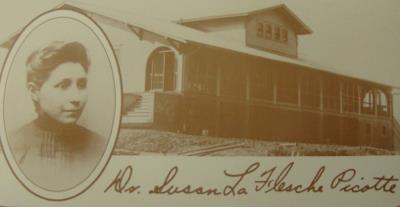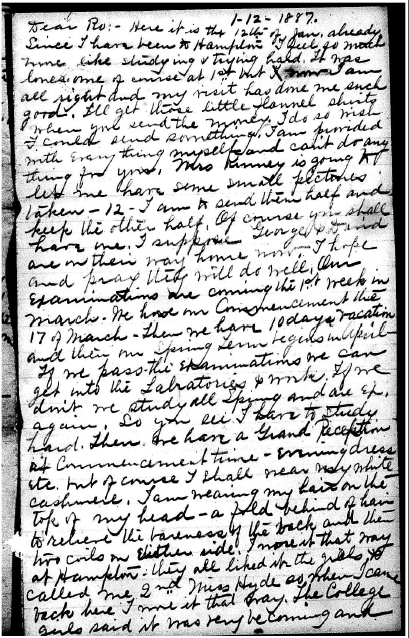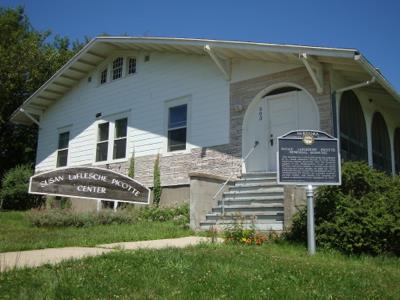Making Invisible Histories Visible
Page Navigation
- Making Invisible Histories Visible
- Lesson Plans and Resources
- iBooks on Omaha and Nebraska History for Primary Students
- Omaha Mapping Projects
-
African American Histories
- African American Artists
- African American Athletes & Facilities
- African American Churches
- African American Civil Rights Organizations - 1950s-1960s
- African American Civil Rights
- African American Contributions to Jazz, Gospel, Hip-Hop
- African American Dramatic Arts
- African American Education - Dorothy Eure & Lerlean Johnson
- African American Educators & Education
- African American Firefighters
- African American Homesteaders
- African American Law Enforcement
- African American Migration to Omaha
- African American Musicians of Omaha
- African American Newspapers
- African American Owned Businesses
- African American Politicians
- African American Social Life
- African American Workers at Omaha's Railroads & Stockyards
- African American Workers at the Naval Ammunition Depot in Hastings
- African Americans in the Civil War
- African Americans in Vietnam
- Charles B. Washington - Journalist and Civil Rights Leader
- Elizabeth Davis Pittman - Lawyer/Judge
- Green Book Omaha
- Marlin Briscoe - Professional Football Player
- Native Omaha Days
- Nebraska's Role in the Underground Railroad
- Sen. Edward Danner - Politician & Civil Rights Activist
- Sudanese Refugees
- Tuskegee Airmen
- European and Asian Immigrant Histories
-
Historic Neighborhoods & Buildings
- 24th and Binney/Wirt/Spencer Streets
- 24th and Lake Streets
- Central Park Neighborhood - 42nd and Grand Avenue
- Dahlman Neighborhood - 10th and Hickory Streets
- Hartman Addition Neighborhood - 16th and Williams Streets
- Indian Hills/Southside Terrace Neighborhood - 30th and Q Streets
- Jefferson Square Neighborhood - 16th and Chicago Streets
- Long Neighborhood - 24th and Clark Streets
- Orchard Hill Neighborhood - 40th and Hamilton Streets
- Smithfield Neighborhood - 24th and Ames Avenue
- St. Mary's Neighborhood - 30th and Q Streets
- Latino Histories
- Music Histories
-
Native American Histories
- Black Elk and John G. Niehardt
- Chief Standing Bear and Susette La Flesche Tibbles
- Dr. Susan LaFlesche Picotte - Native American Doctor
- Native American Education and Boarding Schools
- Native Americans in the Military
- Pre-statehood Interaction of Native Americans and Europeans
- Preserving Native American Tradition
- Restoring the Ponca Tribe
- The American Indian Movement in the 1960s and 1970s
- The Indian Congress at the 1898 Trans-Mississippi Exposition
- The Omaha Native American Indian Tribe
- OPS Elementary School History
- Redlining in Omaha
- Nebraska's Role in the Underground Railroad
- The 1898 Trans-Mississippi Exposition
Dr. Susan La Flesche Picotte - Native American Doctor
-
In what ways did Dr. Susan La Flesche Picotte bridge the gap between the separate spheres of men and women and Nativeness and assimilation in her work?
Dr. Picotte: Changing the Flow
-
 Dr. Susan La Flesche Picotte was a trailblazer. Born in Nebraska on the Omaha Reservation in 1865, Picotte was the first Native American woman in the United States to earn a medical degree. Her father was Joseph La Flesche (Iron Eyes), the last chief of the Omaha Tribe. At a time when most Native Americans were fighting to protect their culture from forced suppression by white Americans, Iron Eyes thought it would be best for his children to receive a white education. He believed this would allow them to have a good future. So, he sent his daughter to a boarding school in 1884 when she was 19.
Dr. Susan La Flesche Picotte was a trailblazer. Born in Nebraska on the Omaha Reservation in 1865, Picotte was the first Native American woman in the United States to earn a medical degree. Her father was Joseph La Flesche (Iron Eyes), the last chief of the Omaha Tribe. At a time when most Native Americans were fighting to protect their culture from forced suppression by white Americans, Iron Eyes thought it would be best for his children to receive a white education. He believed this would allow them to have a good future. So, he sent his daughter to a boarding school in 1884 when she was 19.Dr. Picotte is significant because her life fits into multiple trends in U.S. history. Her life’s story is an example of how women chose to conform to or challenge their expected roles during the 19th and 20th centuries. For example, she chose her education over getting married, which didn’t fit with ideal womanhood. Dr. Picotte and her people also faced the challenge of deciding to assimilate into white culture or to protect their culture from the suppression of white Americans. She and her family believed in assimilation, but she was also proud of her tribal heritage and wanted to help her people. Along with being a physician for the Omaha people at a time when there were few female doctors, Dr. Picotte was an activist for her tribe, visiting Washington D.C. later in her life to fight for their land rights. She was very determined and never gave up at a time when being Native American and being a woman caused many obstacles.
All through her life, she tried to improve the lives and conditions of the people of the Omaha Tribe. One thing she was fighting for was to improve hygiene and to get rid of alcoholism, which in 2015 is still a problem in the tribe because of the effects of poverty and oppression caused by the United States’ treatment of Native Americans. Picotte should be memorialized because she defied the expectations of her gender and her cultural heritage, choosing to give back to her community and becoming one of the most helpful people to her tribe. In West Omaha, she is memorialized by having a school named after her: Picotte Elementary. Dr. Picotte was a very strong and dedicated woman whose legacy lives on to inspire people today.
Image: Dr. Susan La Flesche Picotte and her hospital in Walthill, Nebraska. (Image Courtesy of Susan La Flesche Picotte Center)
Video: A 7 minute video interviewing Princella Parker, an Omaha Tribe member, researcher and the documentary film producer of Dr. Susan La Flesche PIcotte.
"She had a foot in each world."
-
 While away at college in Pennsylvania, Dr. Picotte wrote many letters back to her family in Nebraska. This artifact is a letter written by Susan La Flesche to her sister Rosalie on Jan. 12, 1887. In this letter, she explains an important decision she was making between her education and career or marrying Thomas Ikinicapi (T.I.). This helps us to understand Dr. Picotte more because at a time when women were not supposed to value their education, she chose a unique path by resisting expectations of white women. She also felt pressure to make the decision because the Connecticut Indian Association told her if she married T.I. they would not fund her medical degree. Although she chose to make college a priority when she wrote the letter, later in her career she decided to marry Henry Picotte and had two children. Like many women throughout history, she faced the challenge of social pressures to balance home and career responsibilities.
While away at college in Pennsylvania, Dr. Picotte wrote many letters back to her family in Nebraska. This artifact is a letter written by Susan La Flesche to her sister Rosalie on Jan. 12, 1887. In this letter, she explains an important decision she was making between her education and career or marrying Thomas Ikinicapi (T.I.). This helps us to understand Dr. Picotte more because at a time when women were not supposed to value their education, she chose a unique path by resisting expectations of white women. She also felt pressure to make the decision because the Connecticut Indian Association told her if she married T.I. they would not fund her medical degree. Although she chose to make college a priority when she wrote the letter, later in her career she decided to marry Henry Picotte and had two children. Like many women throughout history, she faced the challenge of social pressures to balance home and career responsibilities.Dr. Picotte really cared for her tribe because she stayed in school so she could take her knowledge back to her reservation. Dr. Picotte dressed and acted like the white women she went to school with but stayed true to her Native roots by coming back to help the reservation and by building a hospital there. As her great-nephew Dennis Farley said, “She had a foot in each world. She followed some traditional ways, and she fit in with the Euro-American elite too.” (Artifact courtesy of La Flesche Family Collection, Nebraska State Historical Society; PDF copy courtesy of Princella Parker)
A Hospital of Hope
-

While Susan La Flesche Picotte was a young doctor on the Omaha Reservation, she longed for a hospital so she would not have to send her patients to Omaha or Sioux City for surgery or seek them out individually on horseback. Picotte also wanted the hospital to show that her tribe didn’t need the government’s help and that the Omaha people could care for their own medical needs. She enlisted the help of community members and raised $10,000, which was enough to build a hospital in Walthill, Nebraska, on the Omaha Reservation. The hospital opened in 1913. It contained two general wards with the capacity of 12 beds, five private wards, a maternity ward, an operating room, two bathrooms, a kitchen, and a reception room. It served both Natives and whites instead of being segregated. Just two years later, Dr. Picotte died at age 50 due to bone cancer in her ear. After her death, the hospital served patients until the 1940s. In 1993, the hospital was declared a national historic landmark that honors her with displays of her life, education, culture, and tribe. In 2015, the hospital museum is open by appointment. Like many small local historical landmarks throughout the U.S., finding enough funding is difficult, so the hospital cannot be open full time and is in need of restoration.
A Lasting Legacy
-
This photo is from an Omaha Public Schools elementary school named after Dr. Susan La Flesche Picotte. The school used to be on 1312 Robertson Drive in Omaha. The school opened in the fall of 1992. A year passed and the school moved on March 25, 1993, to 144th and Ohio streets where it is still to this day. The mascot for Picotte Elementary is a pinto (mustang), representing the horse Dr. Picotte rode to meet her patients before she built the hospital.
The school was named after Dr. Picotte as a symbol of respect for all cultures, since the city was named after her tribe. It was important that OPS chose to name a school after Dr. Picotte because even though Native Americans were the first people in Omaha, there are not many places named in their honor. The school hopes to promote and preserve her legacy to last a lifetime. It inspires students to follow their dreams to become what they want for their life while teaching the next generation about Picotte's loyalty and passion for her community. In Picotte Elementary, there is a mural timeline to illustrate the history of how the school became a reality from the beginning of the Omaha Tribe to the school in 2015. The mural reminds students every day that no matter what challenges they may face, with hard work and determination they can accomplish their dreams.
2015 MIHV Project
Student Reflections
-
“I learned to look behind the names and to look at the story. I liked working with new people, learning about different people and how to tell their story.”
— Heather C.
“At MIHV I’ve learned a lot about Omaha that I never knew existed. I really liked our field trip to North Omaha because I got to learn about its early musical history.”— Adrianna B.
“I learned about Dr. Picotte in this program and saw a little more of Omaha. What I liked most about the program was our visit to South Omaha, especially the food. It is pretty cool with the murals and the restaurants. It reminds me of my hometown.”
— Jathiyah C.
Resources
-
Calloway, Colin G. First Peoples: A Documentary Survey of American Indian History. Fourth Edition. Boston, MA: Bedford/St. Martin’s, 2011.
Ferris, Jeri. Native American Doctor: The Story of Susan Laflesche Picotte. Reprint edition. Minneapolis: Carolrhoda Books, 1991.
Harding, David. “Doctor cared for her people on reservation.” Omaha World Herald. March 26, 2006.
“‘If you knew the conditions…’ Health Care to Native Americans.” U.S. National Library of Medicine. 23 November 2010. https://www.nlm.nih.gov/exhibition/if_you_knew/ifyouknew_02.html (accessed July 27, 2015).
LaFlesche Family Papers. Nebraska State Historical Society. https://www.nebraskahistory.org/lib-arch/research/manuscripts/family/laflesche-family.htm
Lesiak, Christine. “Drums of Change- A Nebraska Story.” NET Television. 16 September 2013. https://netnebraska.org/interactive-multimedia/television/nebraska-stories-drums-change-episode-501-segment-4-4 (accessed July 27. 2015).
Mathes, Valerie Sherer. “Susan LaFlesche Picotte: Nebraska’s Indian Physician, 1865-1915.” Nebraska History 63, no. 4 (Winter, 1982): 502-530.
Parker, Princella and Christine Lesiak. Medicine Woman. NET Television. (FORTHCOMING)
“Picotte Elementary.” Omaha World Herald. October 3, 2009.
Picotte, Susan LaFlesche. “Omahas and the New Order: Indians Opposed to the Consolidation of Agency Superintendents.” Omaha Daily Bee. December 30, 1909. https://chroniclingamerica.loc.gov/lccn/sn99021999/1909-12-30/ed-1/seq-6/#date1=1836&index=5&date2=1922&searchType=advanced&language=&sequence=0&lccn=sn99021999&words=FLESCHE+LA+PICOTTE&proxdistance=5&rows=20&ortext=LaFlesche&proxtext=&phrasetext=&andtext=Picotte&dateFilterType=yearRange&page=1
"Susan La Flesche Picotte," The Biography.com website, https://www.biography.com/people/susan-la-flesche-picotte-9440355 (accessed July 27, 2015).
Susan LaFlesche Picotte Center, Walthill, NE. https://omaha-nsn.gov/all-work-list/susan-laflesche-picotte-house/
Wilkerson, J. L. A Doctor to Her People: Dr. Susan LA Flesche Picotte. Kansas City, MO: Acorn Books, 1999.
Research compiled by: Adrianna B., Heather C., Jathiyah C.

